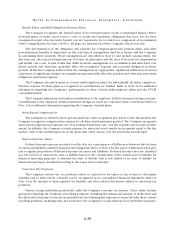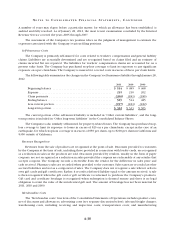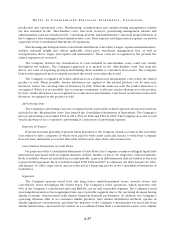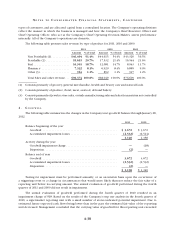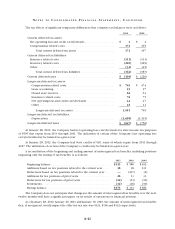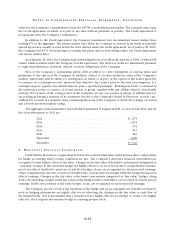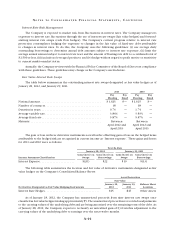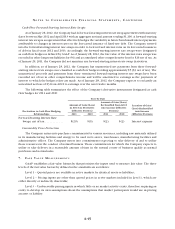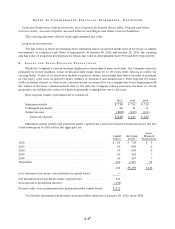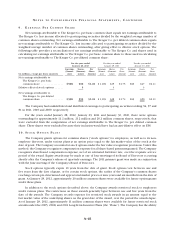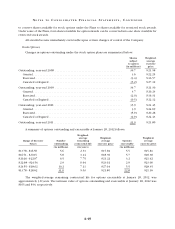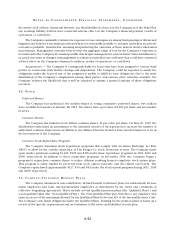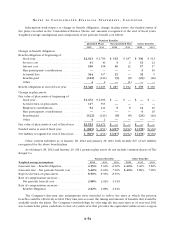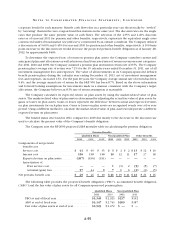Kroger 2011 Annual Report Download - page 100
Download and view the complete annual report
Please find page 100 of the 2011 Kroger annual report below. You can navigate through the pages in the report by either clicking on the pages listed below, or by using the keyword search tool below to find specific information within the annual report.
A-45
NO T E S T O CO N S O L I D A T E D FI N A N C I A L ST A T E M E N T S , CO N T I N U E D
Cash Flow Forward-Starting Interest Rate Swaps
As of January 28, 2012, the Company had 24 forward-starting interest rate swap agreements with maturity
dates between May 2012 and April 2013 with an aggregate notional amount totaling $1,200. A forward-starting
interest rate swap is an agreement that effectively hedges the variability in future benchmark interest payments
attributable to changes in interest rates on the forecasted issuance of fixed-rate debt. The Company entered
into the forward-starting interest rate swaps in order to lock in fixed interest rates on its forecasted issuances
of debt in fiscal years 2012 and 2013. Accordingly, the forward-starting interest rate swaps were designated
as cash-flow hedges as defined by GAAP. As of January 28, 2012, the fair value of the interest rates swaps was
recorded in other long term liabilities for $41 and accumulated other comprehensive loss for $26 net of tax. As
of January 29, 2011, the Company did not maintain any forward-starting interest rate swap derivatives.
In addition, as of January 28, 2012, the Company has unamortized net payments from three forward-
starting interest rate swaps once classified as cash flow hedges totaling approximately $5 ($3 net of tax). The
unamortized proceeds and payments from these terminated forward-starting interest rate swaps have been
recorded net of tax in other comprehensive income and will be amortized to earnings as the payments of
interest to which the hedges relate are made. As of January 28, 2012, the Company expects to reclassify an
unrealized net loss of $3 from AOCI to earnings over the next twelve months.
The following table summarizes the effect of the Company’s derivative instruments designated as cash
flow hedges for 2011 and 2010:
Year-To-Date
Derivatives in Cash Flow Hedging
Relationships
Amount of Gain/(Loss)
in AOCI on Derivative
(Effective Portion)
Amount of Gain/(Loss)
Reclassified from AOCI
into Income (Effective
Portion)
Location of Gain/
(Loss) Reclassified
into Income
(Effective Portion)2011 2010 2011 2010
Forward-Starting Interest Rate
Swaps, net of tax . . . . . . . . . . . . $(29) $(5) $(2) $(2) Interest expense
Commodity Price Protection
The Company enters into purchase commitments for various resources, including raw materials utilized
in its manufacturing facilities and energy to be used in its stores, warehouses, manufacturing facilities and
administrative offices. The Company enters into commitments expecting to take delivery of and to utilize
those resources in the conduct of normal business. Those commitments for which the Company expects to
utilize or take delivery in a reasonable amount of time in the normal course of business qualify as normal
purchases and normal sales.
7. FA I R VA L U E ME A S U R E M E N T S
GAAP establishes a fair value hierarchy that prioritizes the inputs used to measure fair value. The three
levels of the fair value hierarchy defined in the standards are as follows:
Level 1 – Quoted prices are available in active markets for identical assets or liabilities;
Level 2 – Pricing inputs are other than quoted prices in active markets included in Level 1, which are
either directly or indirectly observable;
Level 3 – Unobservable pricing inputs in which little or no market activity exists, therefore requiring an
entity to develop its own assumptions about the assumptions that market participants would use in pricing
an asset or liability.


